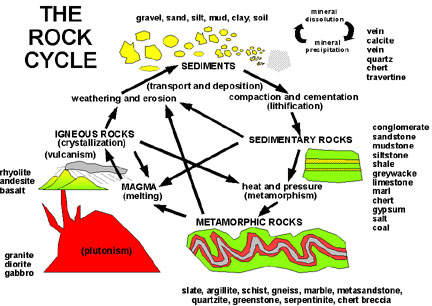Petrology and the Rock Cycle
Homework Help & Tutoring
We offer an array of different online Petrology and the Rock Cycle tutors, all of whom are advanced in their fields and highly qualified to instruct you.
Petrology and the Rock Cycle
There are many different types of rocks, made from different minerals. To see several common types, you can view images at The CUNY Brooklyn Rock Gallery online or visit your local science museum. The Smithsonian, The American Museum of Natural History, and The Academy of Natural Science all have large rock and mineral collections on permanent display.
Rocks can be classified into three broad categories, based-on how they are formed: Sedimentary, Igneous, and Metamorphic.
1) Sedimentary Rocks - Sedimentary rocks are rocks that are formed by a repeated process of deposition and compaction. When a larger rock is weathered, pieces of the material may be carried away by wind, water, or other forces. These particles eventually are deposited and can build-up in one place, commonly at the delta of a river or along the coastline of an ocean. The pile of sediment particles than then become compressed and compacted together, hardening to form rock. These rocks can be further classified by the grain size of sediment they're made from and whether they were the result of chemical or physical weathering. Some common sedimentary rocks are limestone, sandstone, and shale. More information about this topic is available from "Sedimentary Rock" in The Encyclopedia of Earth Science.
2) Igneous Rocks - Igneous rocks are rocks that are formed by melting and cooling. When a volcano erupts, hot, liquid rock - called magma - spews up from inside the earth, but this molten rock doesn't stay melted for very long. It cools and hardens, forming igneous rocks. Thus, igneous rocks are frequently found near volcanoes. These rocks can be further classified by their mineral composition and by their crystal size, which depends on whether they cooled quickly or slowly and whether they formed inside the earth or on its surface. Some common igneous rocks are granite, basalt, and obsidian. More information about this topic is available from "Igneous Rock" in The Encyclopedia of Earth Science.
3) Metamorphic Rocks - Metamorphic rocks are rocks that are formed under intense heat and pressure. When a rock - of any type - is heated (but not actually melted) and held under pressure for long periods of time, its physical properties can be completely altered. Because these new types of rocks have such different physical properties, they are not considered the same type of rock anymore. These are metamorphic rocks. Metamorphic rocks can be further classified by what type of rock they were originally formed from and whether or not they have visible layers. Some common metamorphic rocks are marble, schist, and slate. More information about this topic is available from "Metamorphic Rock" in The Encyclopedia of Earth Science.
These three rock-types are constantly evolving and changing into each other in a process known as the Rock Cycle, shown below.

To fulfill our tutoring mission of online education, our college homework help and online tutoring centers are standing by 24/7, ready to assist college students who need homework help with all aspects of petrology and the rock cycle. Our earth science tutors can help with all your projects, large or small, and we challenge you to find better online petrology and the rock cycle tutoring anywhere.
College Petrology and the Rock Cycle Homework Help
Since we have tutors in all Petrology and the Rock Cycle related topics, we can provide a range of different services. Our online Petrology and the Rock Cycle tutors will:
- Provide specific insight for homework assignments.
- Review broad conceptual ideas and chapters.
- Simplify complex topics into digestible pieces of information.
- Answer any Petrology and the Rock Cycle related questions.
- Tailor instruction to fit your style of learning.
With these capabilities, our college Petrology and the Rock Cycle tutors will give you the tools you need to gain a comprehensive knowledge of Petrology and the Rock Cycle you can use in future courses.
24HourAnswers Online Petrology and the Rock Cycle Tutors
Our tutors are just as dedicated to your success in class as you are, so they are available around the clock to assist you with questions, homework, exam preparation and any Petrology and the Rock Cycle related assignments you need extra help completing.
In addition to gaining access to highly qualified tutors, you'll also strengthen your confidence level in the classroom when you work with us. This newfound confidence will allow you to apply your Petrology and the Rock Cycle knowledge in future courses and keep your education progressing smoothly.
Because our college Petrology and the Rock Cycle tutors are fully remote, seeking their help is easy. Rather than spend valuable time trying to find a local Petrology and the Rock Cycle tutor you can trust, just call on our tutors whenever you need them without any conflicting schedules getting in the way.



